I love collecting art and setting up my gallery walls. But hanging art on concrete walls was always a challenge. I found ways to make it easy and stylish. In this guide, I’ll share my best tips to turn your concrete wall into a beautiful art showcase.
It might seem hard to hang art on concrete walls, but it’s doable. With the right tools and a bit of knowledge, you can make your space look amazing. This guide is for anyone who wants to create a stunning gallery wall that shows off their style.
Table of Contents
Essential Tools and Materials for Concrete Wall Mounting
Hanging artwork on a concrete wall needs special tools and materials. This ensures a secure and lasting installation. It’s important to have the right equipment for a successful project.
Power Tools and Drilling Equipment
To drill into concrete, use a hammer drill with a masonry bit. This tool has enough power to go through the dense concrete. It makes clean, sturdy holes for your wall anchors. You might also need a concrete drill bit for accurate drilling.
Mounting Hardware and Supplies
The choice of concrete wall hanging hardware depends on your artwork’s weight. You can use concrete wall anchors, masonry screws, or metal hooks or brackets. Pick the right hardware for your concrete wall drilling for art project.
Safety Equipment
Drilling into concrete can be dusty and dangerous. So, wear the right safety equipment. This includes safety goggles to protect your eyes and a dust mask to avoid harmful particles.
| Tool/Material | Purpose |
|---|---|
| Hammer Drill | Drilling into concrete walls |
| Concrete Drill Bit | Creating sturdy holes for wall anchors |
| Concrete Wall Anchors | Securing artwork to the concrete wall |
| Masonry Screws | Attaching mounting hardware to the wall |
| Safety Goggles | Protecting eyes from dust and debris |
| Dust Mask | Preventing inhalation of harmful particles |
With the right concrete wall hanging hardware and concrete wall drilling for art tools, you can safely hang your artwork. This ensures a successful installation on a concrete wall.
Understanding Different Types of Concrete Wall Anchors
Choosing the right anchors is key when hanging art on concrete walls. There are many types of anchors, each designed for different weights and uses. Knowing your options can help you hang your art securely and lastingly.
Plastic expansion anchors are great for light to medium-weight art. They expand in the hole, gripping the concrete tightly. For heavier items, like big mirrors or shelves, concrete sleeve anchors or wedge anchors are better. They offer a stronger hold, perfect for heavier weights.
Adhesive hooks or strips are easy for very light art, but might not last as long as mechanical anchors. Masonry anchors, or concrete screws, are another choice. They come with screws for easy insertion into the concrete.
| Anchor Type | Recommended Use | Weight Capacity |
|---|---|---|
| Plastic Expansion Anchors | Lightweight to medium-weight art | Up to 50 lbs |
| Concrete Sleeve Anchors | Heavier art, mirrors, or shelves | 50 lbs and above |
| Concrete Wedge Anchors | Heavier art, mirrors, or shelves | 50 lbs and above |
| Adhesive Hooks/Strips | Very light art | Up to 10 lbs |
| Masonry Anchors (Concrete Screws) | Light to medium-weight art | Up to 50 lbs |
When picking concrete wall anchors, think about your art’s weight and size, and your wall’s type. Following manufacturer advice can help you hang your concrete wall studs for hanging art securely and for a long time.
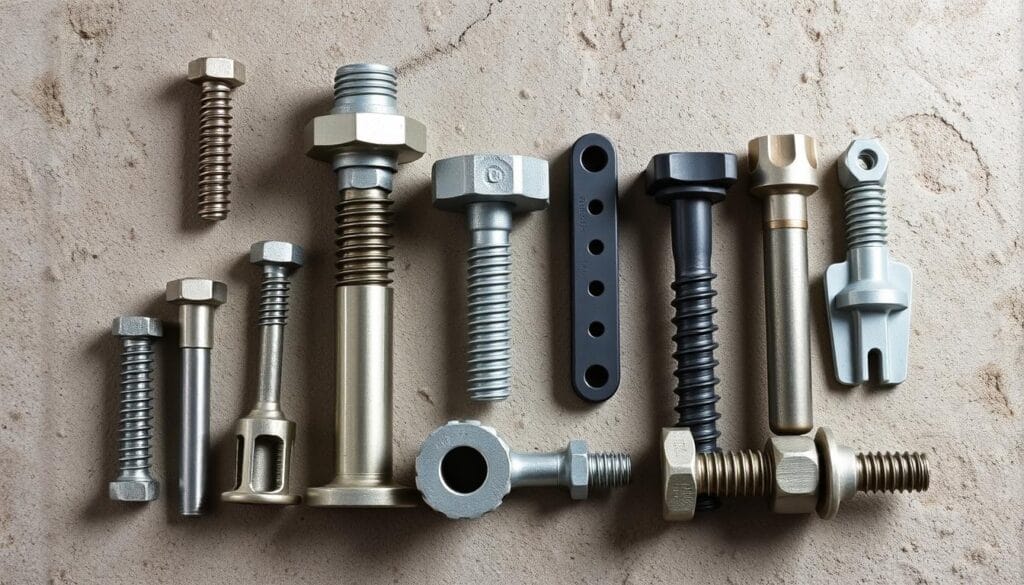
How to Hang Art on Concrete Wall: Step-by-Step Process
Hanging art on concrete walls needs more planning than on drywall. But, with the right tools and techniques, you can mount your art securely. This will make your display look amazing. Let’s go through the steps to hang art on concrete walls.
Planning and Measuring
First, pick the perfect spot on your concrete wall for your artwork. Place the artwork’s center at eye level, about 57-60 inches from the floor. After choosing the spot, mark it with a tape measure for drilling.
Drilling Techniques
To drill into concrete, use a masonry drill bit. Apply slow, steady pressure to avoid cracking the wall. Clean out dust between drills to ensure a tight fit for the anchors.
Installing Anchors and Hardware
For light to medium-weight art, plastic expansion anchors work well. For heavier art or mirrors, use concrete sleeve or wedge anchors. Make sure the anchors are flush with the wall for a clean look.
After installing anchors, attach the right hardware, like screws or hooks, to hang your art. Use felt pads or bumpers on the back to prevent wall scratches.
By following these steps, you can hang your concrete wall art successfully. Check the hardware’s stability often. Also, protect your art from sunlight and moisture to keep it looking great.
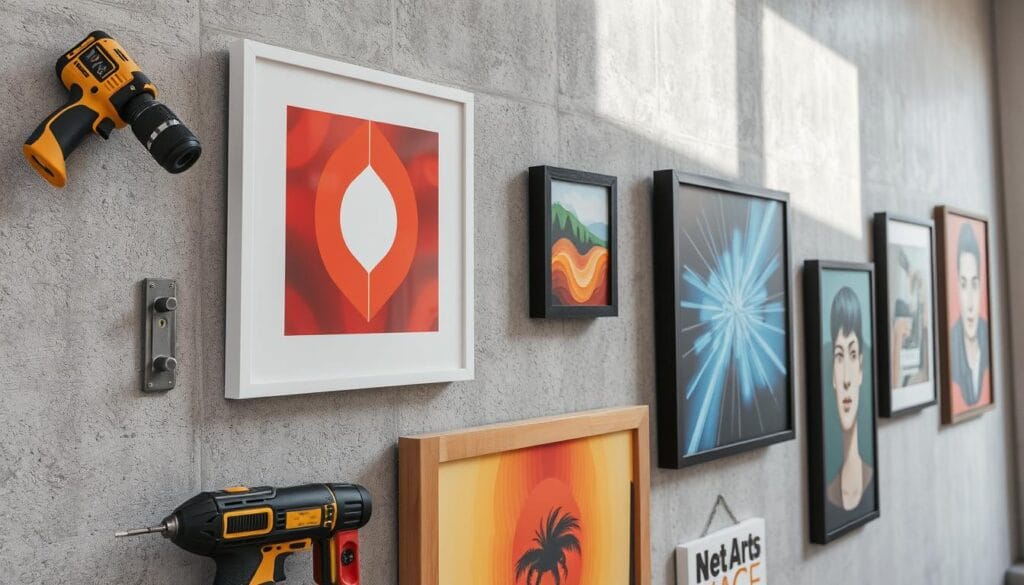
Weight Considerations and Hardware Selection
When hanging art on a concrete wall, weight is key. The artwork’s weight decides the anchors and hardware you need. This ensures a safe and secure installation.
For art up to 8 pounds (3.6 kg), adhesive hooks work well. They’re easy to put up and hold a fair amount of weight. But, for art up to 25 pounds (11 kg), hardwall hangers are better. They offer a stable and secure way to mount.
For art over 25 pounds (11 kg), masonry anchors are the top choice. They’re made for concrete and masonry walls, giving a strong hold. Make sure to pick anchors and screws that can handle at least 1.5 times the art’s weight. This ensures a lasting and secure hold.
For very heavy pieces, using two anchors can add extra support. This is great for big or odd-shaped art that needs extra stability.
| Mounting Hardware | Weight Capacity |
|---|---|
| Adhesive Hooks | Up to 8 pounds (3.6 kg) |
| Hardwall Hangers | Up to 25 pounds (11 kg) |
| Masonry Anchors | Over 25 pounds (11 kg) |
It’s wise to choose hardware that can handle more than your art’s weight. This way, you ensure a safe and lasting installation on your concrete wall.
Alternative Mounting Solutions Without Drilling
Hanging art on concrete walls doesn’t always mean drilling holes. There are many other ways to display your artwork without damaging your walls. You can use adhesives, freestanding displays, or other methods. These options are great for renters, those who don’t want to drill, or anyone looking for a unique way to decorate their walls.
Adhesive Options
Adhesive hangers and hooks are perfect for hanging light art on concrete walls. They are easy to remove and won’t leave much damage. Just make sure to follow the weight limits and instructions from the manufacturer for the best results.
Mounting Systems
Picture hanging systems that attach to the ceiling are another great choice. They let you change and adjust your artwork easily. This makes them a flexible and safe way to display your art.
Freestanding Displays
- Easels are perfect for big rooms, creating a centerpiece for your art without needing to attach it to the wall.
- Pegboards are customizable for hanging art, with only the pegboard needing to be drilled into the wall.
- Plate hangers are made for showing off decorative plates without the need for nails.
While these alternatives work well, remember to think about your artwork’s weight and size. For heavier pieces or if you’re unsure about your wall, it’s wise to get professional advice.
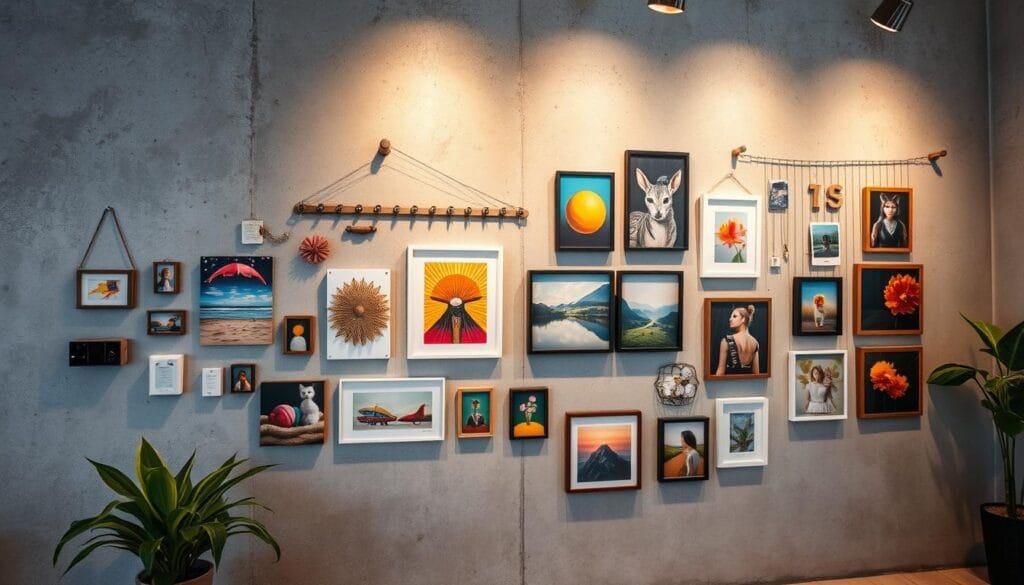
Best Practices for Drilling Into Concrete Walls
Hanging art on concrete walls needs a special approach for a secure and professional look. Drilling into the concrete is a key step. By following best practices, you can get a successful and safe result when drilling into concrete walls for art.
For concrete wall drilling for art, a hammer drill is the essential tool. It’s made to handle tough concrete, providing the needed force and rotation for clean holes. Start with a slower speed and increase the drill’s RPM as you go.
- Begin with a pilot hole: Start by drilling a smaller pilot hole at a slow speed. This helps establish the entry point and prevents cracking or chipping the concrete.
- Maintain steady pressure: Apply firm, consistent pressure while drilling. Keep the drill bit, shaft, and your arm parallel to the floor for optimal control and accuracy.
- Clear debris regularly: Pause periodically to remove any concrete dust or debris from the hole. This prevents overheating and ensures a clean, well-defined drilling site.
When drilling into cement walls, use a slower speed setting. This manages the denser material and lowers the risk of damaging the wall or the drill bit.
“The key to successful concrete wall drilling is patience, precision, and the right tools. Take your time, maintain steady pressure, and clean out the hole regularly for the best results.”
By following these best practices for how to hang art on concrete wall, you can ensure a secure and professional installation. This will showcase your artwork with confidence.
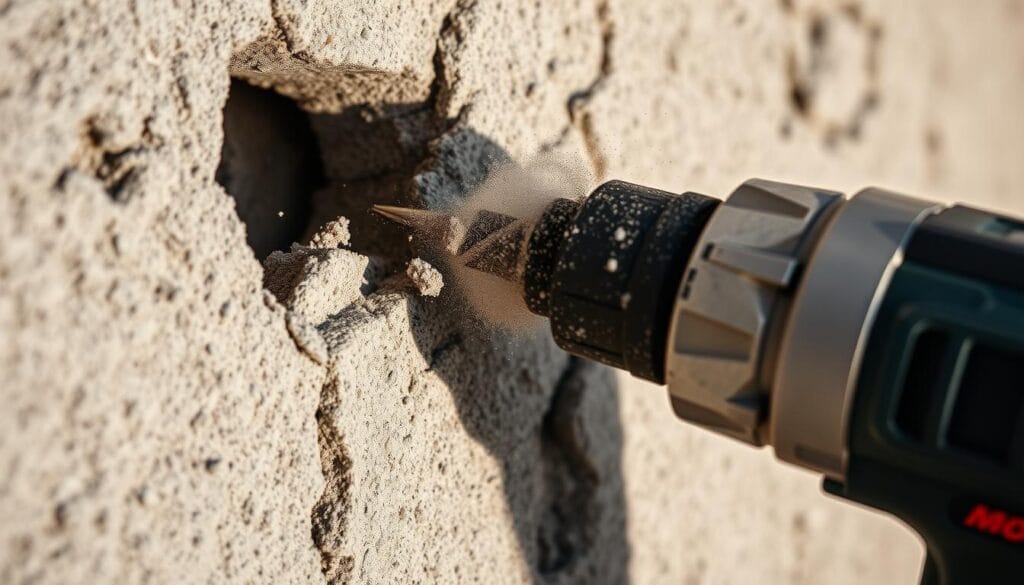
Safety Measures and Wall Assessment
Before you start hanging your artwork on a concrete wall, safety first. Use a wall scanner to find hidden wiring or plumbing. This step helps avoid accidents and costly damages.
Next, check the wall’s structure. Look for water damage, cracks, or other issues. These could harm your artwork’s stability. Also, check local building codes, especially if you rent the space.
Checking for Utilities
- Use a wall scanner to detect hidden electrical wiring or plumbing
- Avoid drilling into areas where utilities could be concealed
- Consult local building codes for any special requirements
Structural Considerations
- Inspect the wall for signs of water damage or structural issues
- Assess the age and overall condition of the concrete wall
- Consider the weight-bearing capacity of the wall
Personal Protection Equipment
Wear the right gear when drilling into the concrete wall. Safety goggles, a dust mask, and sturdy gloves are must-haves. These simple steps ensure a safe art installation.
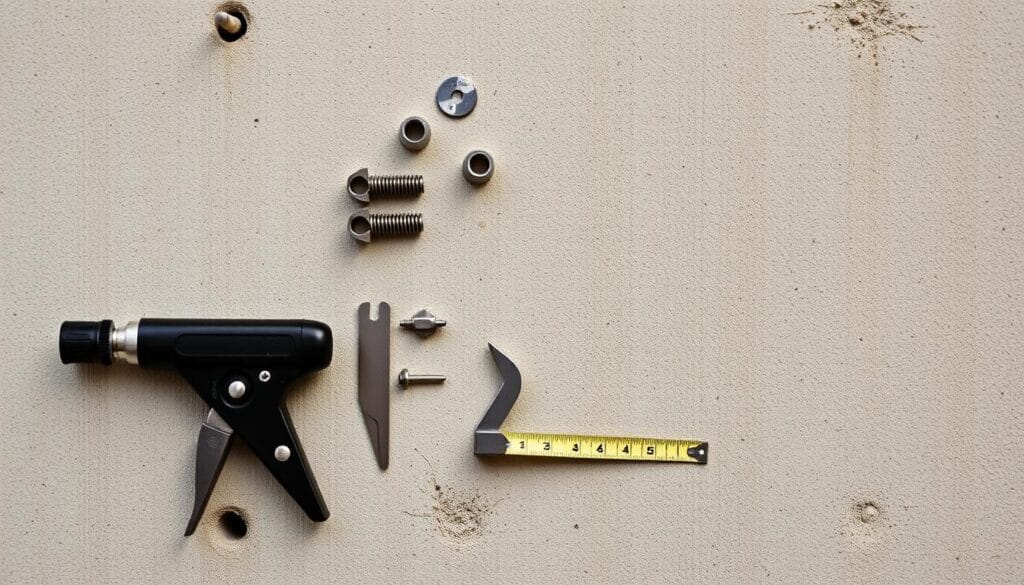
Assessing the wall and taking safety steps are key to secure art hanging. By following these tips, you can safely enjoy your artwork on concrete for years.
Maintaining Your Wall Art Installation
Keeping your concrete wall art installation in top shape is crucial. To protect your frames and the concrete, use felt pads on the back of frames. These pads act as a cushion, preventing scuff marks or paint damage.
Also, adding rubber bumpers around your frames’ edges can help absorb minor impacts. This step is key to keeping your concrete wall art installation and secure art hanging on concrete safe. These easy steps can greatly help in keeping your wall display looking perfect.
Watching the humidity levels in your concrete walls is also important. Changes in moisture can harm your artwork. Using a dehumidifier in areas with high moisture can help protect your valuable pieces.
- Regularly check the mountings and hardware for safety and stability to ensure your concrete wall art installation remains securely in place.
- Use felt pads on the back of frames to prevent direct contact with the concrete wall and minimize scuff marks or paint damage.
- Install rubber bumpers around the edges of your frames to absorb minor impacts and further protect the wall and artwork.
- Monitor humidity levels in concrete walls and use a dehumidifier if necessary to maintain a stable environment for your artwork.
By sticking to these simple maintenance tips, you can enjoy your concrete wall art installation for many years. This ensures your artwork stays securely and beautifully on your concrete walls.
Troubleshooting Common Installation Problems
When hanging art on concrete walls, you might face a few common issues. But, with the right techniques, you can solve them easily. One big problem is crumbling concrete, which makes it hard to secure anchors well. To fix this, use a concrete patching compound to fill cracks or crumbling areas before you start.
Fixing Loose Anchors
If your anchors start to loosen, you need to take extra steps for a secure hold. First, remove the old anchors and fill the holes with concrete filler or epoxy. After the filler dries, you can re-drill the holes and put in new anchors that can hold the weight of your artwork.
Adjusting Uneven Hangings
Getting a perfectly level and evenly spaced hanging can be tough, especially on uneven concrete walls. Use a spirit level to find any uneven spots. Then, make small changes to the hanging hardware, like tightening or loosening screws, to get the frame aligned right. Always check if your wall art is stable and aligned, as the concrete might shift over time, needing more adjustments.
FAQ
What are the essential tools and materials needed for hanging art on concrete walls?
You’ll need a drill with a masonry bit, concrete wall anchors, and screws or hooks. Also, a tape measure, pencil or chalk, level, and hammer are important. A hammer drill is best for drilling into concrete.
What types of concrete wall anchors are available, and how do I choose the right one?
There are many types of concrete wall anchors. Plastic expansion anchors work for lightweight to medium-weight art. For heavier art or mirrors, use concrete sleeve anchors or wedge anchors.
Adhesive hooks or mounting strips are good for very light art. Masonry anchors, or concrete screws, are plastic and come with screws for easy insertion.
What is the step-by-step process for hanging art on a concrete wall?
First, pick the right spot and mark the wall. Then, choose the right anchors and drill into the wall. Use a masonry bit and apply slow, steady pressure to avoid cracking the wall.
After drilling, clean out concrete dust. Next, insert the wall anchors and secure them with screws or hooks. Finally, hang your artwork.
How do I determine the appropriate hardware for my artwork based on weight?
Adhesive hooks are good for items up to 8 pounds. Hardwall hangers can hold up to 25 pounds. For heavier items, use masonry anchors.
Always pick anchors and screws that can handle at least 1.5 times the weight of your art. For very heavy pieces, use two anchors.
What are some alternative mounting solutions for hanging art on concrete walls without drilling?
For lightweight pieces, use adhesive hooks or strips. Concrete nails are good for small, lightweight art. Freestanding art displays, like easels or stands, are also options.
Picture hanging systems that mount from the ceiling are another choice. For medium-weight pieces, consider adhesive mounting brackets.
What safety measures should I take when drilling into concrete walls?
Before drilling, check for hidden wiring or plumbing with a wall scanner. Look for signs of water damage or structural issues. Wear protective goggles and a dust mask when drilling.
Also, check building codes, especially in rental spaces.
How do I maintain my wall art installation on a concrete wall?
Use felt pads to protect the back of frames. Install rubber bumpers to prevent wall contact. Consider the humidity levels in concrete walls, which can affect your artwork.
If needed, use a dehumidifier. Regularly check mountings for safety and stability, as anchors may loosen over time.
What are some common problems that can arise when hanging art on concrete walls, and how do I troubleshoot them?
Problems include crumbling concrete, loose anchors, and uneven hangings. For crumbling concrete, use a concrete patching compound before installation.
If anchors become loose, remove them and fill the holes with concrete filler before re-drilling. To adjust uneven hangings, use a level and make small adjustments to the hanging hardware.


1 thought on “How to Hang Art on Concrete Wall – Simple Guide”